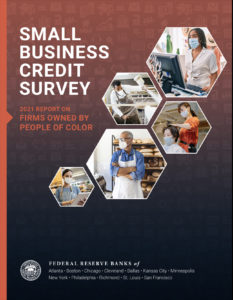 Small Business Credit Survey: 2021 Report on Firms Owned by People of Color
Small Business Credit Survey: 2021 Report on Firms Owned by People of Color
Federal Reserve Bank of Philadelphia
First published April 2021
The COVID-19 pandemic has deeply impacted communities of color and small busi- nesses of color, in many cases to a greater extent than their white counterparts. Prior to the pandemic, small businesses owned by people of color, in aggregate, faced greater challenges than white-owned firms The 2020 Small Business Credit Survey (SBCS) provides evidence that the pandemic exacerbated those challenges, an important finding as those businesses continue to weather the impact of the COVID-19 pandemic.
At the time of the 2020 SBCS—six months after the onset of the pandemic—the US economy had undergone a significant contraction of economic activity. The SBCS finds that firms owned by people of color, both small employer firms and nonemployer firms, were among the firms most likely to experience financial and operational challenges stemming from the pandemic. The challenges these firms are facing are concerning, given the important role the firms play in wealth building and employ- ment in communities of color and, more broadly, in the overall economy.
While firms owned by people of color account for just 18% of small employers,5 they are a rapidly growing segment of small businesses, increasing at a rate of 11% com- pared to white-owned firms (1%) between 2014 and 2016.6 Yet firms of color continue to face structural barriers in acquiring the capital, knowledge, and market access necessary for growth. The SBCS finds that firms owned by people of color tend to have weaker banking relationships, experience worse outcomes on credit applications, and are more reliant on personal funds.
The challenges that firms of color disproportionately face make it important to disaggre- gate small business outcomes by race and ethnicity of firm ownership. Understanding the differences between the experiences of Black-, Asian-, and Hispanic-owned firms can help policymakers better address the unique needs of small businesses of color and implement programs to support the sur- vival of these small firms and their recovery from the effects of the pandemic.
Download Resource